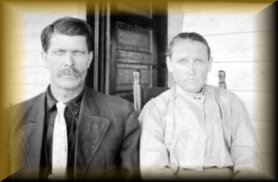
This article was copied from The Shelby Daily
Star's "A Century OF Cleveland Co History"
Cassie Tarpley
- Star Staff Writer
![]() Lawndale Dummy
Lawndale Dummy

LAWNDALE - Lamar Wilson, the careful keeper of much of Cleveland County's history at the Cleveland County Historical Museum, never saw the unique narrow-gauge railroad called the Lawndale Dummy in operation.
"My dad took me to see this train one day when I was a little boy," he said. "It was one engine and they had it up on blocks on West Warren Street, where the ABC store is now, getting ready to be hauled away for scrap metal.
"My dad said, 'That engine's leaving and we better go look at it now.'"
With the dismantling during World War II of the Lawndale Railway and Industrial Co., a big part of Upper Cleveland's history went by the wayside.
From Leif Ericson to Christopher Columbus to the covered wagons of the American West, transportation had always been a key to expansion and growth.
Just as the century turned, a little key with a big impact was born in Upper Cleveland, the brainchild of former Confederate officer Maj. H.F. Schenck, who had become a textile baron with his Cleveland Cotton Mills in Lawndale.
Business boomed at his mills along the First Broad River, and Schenck looked for ways to keep up with the times - using electricity and steam to drive his machinery. The little railroad he dreamed of would bring coal to the mills.
In its 44-year history, it brought a lot more.
Schenck announced his plans in February 1899, and Flem Ramseur of the Double Shoals community surveyed the line layout. By May, construction was underway, supervised by building contractor Rush Oates. Schenck spent $49,782 on the line, which was completed Nov. 11, 1899.
The nine miles of narrow gauge line stretched south from Schenck's Factory in Lawndale to a junction at Dover Mill with the Southern and Seaboard rail lines. That gave a vital connection to the two rail companies' depots in Shelby.
Treated as an extension of the mill business for the first few years, in 1903 the Dummy officially became known as the Lawndale Railway and Industrial Co., with Schenck as president, general manager and traffic manager. He took such a personal interest, so the story goes, that on return trips from Shelby, he required his engineers to blow the whistle long and loud while still a mile away from the mill, so he could personally meet the train.
Zollie Riviere ran the engineer's job from 1903 to 1917.
"My dad's uncle, Buren Wilson, was the engineer from 1917 until he died in 1941," Wilson said, looking at photographs in a rail fancier's magazine, "Narrow Gauge and Short Line Gazette."
"Here's his name on the side of the engine - B.B. Wilson," he pointed out.
Other well-known names included brakeman "Stick" Elliott, his given name long forgotten in lieu of his job description; conductor Johnny Lattimore; and roadmaster Haig Metcalf, who worked for the Dummy Line its entire life span.
A mixture of stories on the origin of the name "dummy" fail to solve the puzzle, but make amusing reading, Wilson said.
One version said it stemmed from the practice of backing the train all the way to Lawndale on the trip north. Another credits a popular song parody on Henry Ford's first cars - "Some Folks Say That the Dummy Don't Run, but Let Me Tell You What the Dummy Done Done" - and says several southern short line railroads bore the funny name.
Cotton was king of the Dummy's cargo, and the line also hauled lumber, coal, agriculture supplies and farm produce.
Plans to add lines south to Stice Shoals and north to Casar never materialized. If the northern extension had been built, it perhaps would have pushed Cleveland County's role in the mining of monazite - a source of thorium nitrate used in gas light mantles - that began about the turn of the century. The mineral deposits were rare, one of perhaps six sites around the world, and attracted the interest of several large companies and inventor Thomas Edison.
In addition to serving Cleveland Cotton Mills and delivering goods to farmers and merchants along the route, the little train became a major transportation link to everyone from traveling salesmen to sightseers to students headed to boarding school.
If it were not for the Dummy, many young folks might have remained just that. The rail line carried hundreds of students to Lawndale's Piedmont High School, which opened in 1897 and grew to be the second-largest private school in the state.
Scheduled stops for the little train were located at Lawndale Junction (at Dover Mill), Metcalf and Double Shoals, but for passengers and freight delivery, it stopped where needed.
Even though 1941 proved its busiest year, the Lawndale Dummy died before the end of World War II, the victim of the burgeoning freight trucking industry. The last train ran April 30, 1943, and most of its cars were dismantled and sold for the scrap metal in high demand in the war years.
An old boxcar is now the pride of Lawndale's historical museum, and the Cleveland museum has one of the old locomotive bells.
Story sources included "Our Heritage: A History of Cleveland County" published by The Shelby Star in 1976, and an article by Lee Rainey in the September-October, 1983, edition of "Narrow Gauge and Short Line Gazette." Photographs used by permission of Benchmark Publications, Ltd., Los Altos, Calif.

Photo courtesy of Tom Hord, Lawndale Auto Supply
